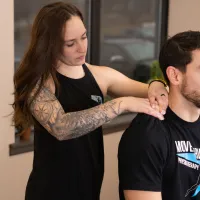LIVE Fighter Workshops: See if you're a fit →
Blog Articles

What Is the Rotator Cuff and How Do Injuries Happen? A Guide for Fighters
Hey team! Let’s take a closer look at what helps you swing those powerful punches and maintain control during grappling—your rotator cuff! If you want to keep fighting strong, understanding this crucial part of your shoulder is a must. Today, we'll break down what the rotator cuff is, how it works, and how injuries can happen during your training and fights.
What Is the Rotator Cuff?
Your rotator cuff is a group of four muscles and their associated tendons that surround the shoulder joint. Think of it as the foundation that keeps your shoulder stable and allows you to lift, rotate, and control your arm movements. It’s made up of the supraspinatus, infraspinatus, teres minor, and subscapularis muscles. Together, they create a strong yet flexible support system for your shoulder, helping you deliver those knockout punches and maintain control when defending against your opponent.
When you throw a punch, grapple, or block, these muscles ensure that your shoulder stays in the right position, giving you the range of motion and strength needed to perform at your best. Without a strong rotator cuff, you’d lose the stability and power that make you effective in the ring.
How Rotator Cuff Injuries Happen
Unfortunately, the same actions that make you a great fighter—powerful punches, fast movements, and grappling—can put stress on the rotator cuff over time. Here’s how injuries can occur:
Overuse and Repetitive Strain: In combat sports, it’s common to repeat similar motions over and over, whether it’s hitting the bag, working on technique, or sparring. This repetitive motion can lead to micro-tears in the rotator cuff muscles, causing inflammation and weakness. Over time, without proper rest and recovery, these micro-tears can build up, leading to chronic issues like tendinitis.
Acute Trauma or Sudden Injury: In some cases, a single event can cause a rotator cuff injury. For example, taking a hard fall, getting caught in a bad position during grappling, or a sudden, awkward movement can put a lot of pressure on the rotator cuff. This can result in partial or complete tears of the tendons, which may require more intensive recovery and rehabilitation.
Lack of Proper Warm-Up: Jumping into intense training without warming up your shoulder muscles is like asking for trouble. Cold muscles are more prone to strains and tears, especially during the dynamic movements that fighters use. Taking just a few minutes to get those muscles warmed up can make a big difference in preventing injuries.
Symptoms of a Rotator Cuff Injury
How can you tell if your rotator cuff is injured? Here are some common symptoms to look out for:
Pain when lifting or rotating your arm: This is one of the first signs of a rotator cuff issue. If simple movements like reaching overhead or lifting your arm out to the side cause discomfort, it might be time to take a closer look.
Weakness in the shoulder: If you notice that your arm feels weaker than usual, especially when performing movements you’ve done countless times before, it could be due to a strain or tear in the rotator cuff.
Pain while sleeping: Many fighters notice increased pain when lying on the injured shoulder at night, which can disrupt sleep. This is often due to the pressure on the inflamed tendons or muscles.
A dull, aching pain that doesn’t seem to go away can also indicate an issue with the rotator cuff, especially if it worsens with use.
Closing Thoughts: Keep Your Shoulders Healthy and Stay in the Fight
Knowing how your rotator cuff works and how it can get injured is the first step in taking care of your body and extending your time in the ring. By warming up properly, recognizing symptoms early, and respecting your body’s need for recovery, you can reduce the risk of injuries and keep throwing those powerful punches without interruption.
Stay tuned for more tips on keeping your shoulders strong and healthy. Got questions or want to know more about rotator cuff care? Drop them in the comments below, and let’s keep fighting strong and smart!

